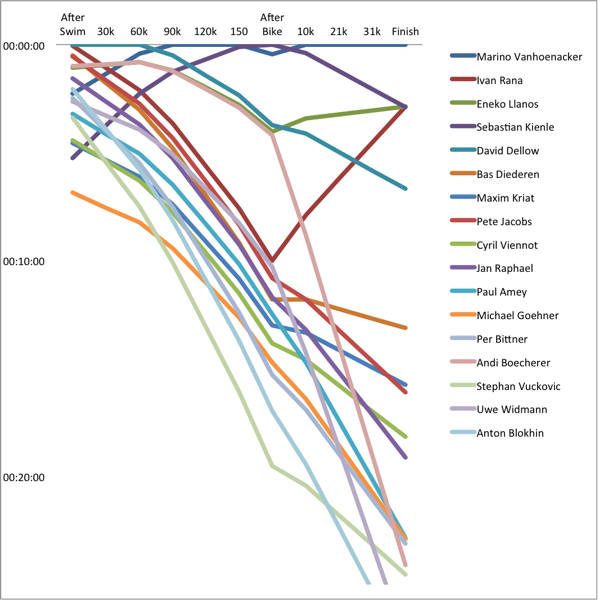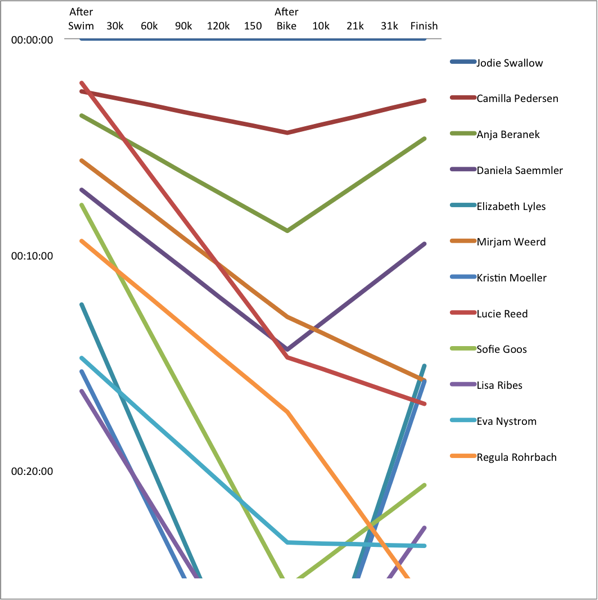Challenge Roth 2013 – Analyzing Results
Race Conditions
As usual, the Roth race was very quick. An adjustment of 19:41 is pretty much in line with the course rating of 18:10. The difference to “slow” years comes mainly from a quick bike ride (12:43 this year as compared to 5:13 from last year). Apparently, the good weather on race day helped to go quick without any impact on run times.
One comment to the results: Roth is one of the few races that does not have a “Pro” category. As I am focusing on Pro result, I have to figure out who’s a Pro by comparing names with athletes that I already have in my database. This means that I don’t include athletes that are racing Pro in a long distance race for the first time or that have recently changed names. (Some examples: This year I am not including 8th place overall Roeland Smits – I don’t have any other professional results for him. Last year I have missed Julia Gajer as she recently changed her name from Julia Wagner.)
Male Race Results
After his disappointing finish in Cozumel (with a 4:30 run in order to validate his Kona slot), Dirk Bockel won in a convincing fashion by pulling away on the bike and then still posting an excellent 2:48 marathon. His 7:52 is the fastest 2013 performance, both is absolute and adjusted times. With such a great performance, last year’s winner, James Cunnama, had to be happy with second place. Timo Bracht wanted to challenge for the win, but after technical issues on the bike (apparently his rim got damaged) he was happy with running onto the podium. (Even if his 2:44 was close to his expected marathon time, it was still the second fastest run time.)
| Rank | Name | Nation | Swim | Bike | Run | Time | Diff to expected |
| 1 | Dirk Bockel | LUX | 00:46:05 | 04:15:05 | 02:48:41 | 07:52:01 | -30:52 |
| 2 | James Cunnama | ZAF | 00:48:38 | 04:23:46 | 02:49:16 | 08:04:13 | -15:50 |
| 3 | Timo Bracht | GER | 00:48:31 | 04:32:09 | 02:44:55 | 08:08:18 | 04:51 |
| 4 | Markus Fachbach | GER | 00:48:35 | 04:24:23 | 02:56:34 | 08:12:13 | -16:06 |
| 5 | Miquel Blanchart | ESP | 00:48:36 | 04:38:38 | 02:43:36 | 08:13:25 | -06:33 |
| 6 | Konstantin Bachor | GER | 00:48:36 | 04:19:30 | 03:07:11 | 08:17:55 | -06:41 |
| 7 | Sergio Marques | POR | 00:53:09 | 04:39:14 | 02:48:14 | 08:23:40 | -18:21 |
| 8 | Petr Vabrousek | CZE | 00:54:35 | 04:35:19 | 02:53:12 | 08:26:26 | -09:10 |
| 9 | Erik-Simon Strijk | NDL | 00:51:49 | 04:37:15 | 02:54:57 | 08:26:54 | -16:43 |
| 10 | Andrej Vistica | CRO | 00:53:06 | 04:34:14 | 02:57:58 | 08:28:05 | -01:08 |
| 11 | Bernd Hagen | GER | 00:55:42 | 04:37:46 | 02:54:35 | 08:31:18 | -11:58 |
| 12 | Marcus Buechler | GER | 00:53:12 | 04:40:48 | 02:57:38 | 08:34:45 | -05:35 |
| 13 | Dylan McNeice | NZL | 00:45:58 | 04:45:18 | 03:01:23 | 08:36:26 | 21:02 |
| 14 | Stephen Bayliss | GBR | 00:46:03 | 04:39:56 | 03:09:00 | 08:38:00 | 01:56 |
| 15 | Mike Schifferle | SUI | 00:59:50 | 04:36:44 | 02:56:41 | 08:38:25 | -07:02 |
| 16 | Andreas Niedrig | GER | 00:46:09 | 04:43:19 | 03:15:36 | 08:48:30 | -45:49 |
| 17 | Egoitz Zalakain | ESP | 00:54:52 | 04:38:45 | 03:16:43 | 08:53:52 | -03:46 |
| 18 | Lothar Leder | GER | 00:53:14 | 04:40:54 | 03:18:16 | 08:55:26 | 08:28 |
| 19 | Christian Saemmler | GER | 00:53:10 | 04:58:25 | 03:07:51 | 09:02:37 | n/a |
| 20 | Andreas Borch | DEN | 00:49:03 | 04:45:20 | 03:25:23 | 09:04:01 | 19:51 |
| 21 | Justin Granger | AUS | 00:54:52 | 04:59:15 | 03:07:58 | 09:06:11 | -03:51 |
| 22 | Maik Paetzold | GER | 00:46:07 | 04:43:29 | 03:46:49 | 09:19:21 | n/a |
| 23 | Mark White | GBR | 00:58:35 | 05:02:10 | 03:17:06 | 09:23:06 | 13:37 |
| 24 | Jens Gydesen | DEN | 00:56:51 | 04:49:06 | 03:37:28 | 09:26:53 | -14:35 |
| 25 | Chris Goodfellow | GBR | 00:54:47 | 04:48:37 | 03:45:30 | 09:32:28 | 52:43 |
| 26 | Georg Potrebitsch | GER | 00:48:29 | 04:29:18 | 04:13:33 | 09:34:16 | 14:39 |
| 27 | Cameron Brown | NZL | 00:48:39 | 04:28:58 | 04:17:18 | 09:37:57 | 31:41 |
| 28 | Till Schramm | GER | 00:54:48 | 04:39:12 | 04:00:21 | 09:37:57 | n/a |
| 29 | Daniel Luna | ESP | 00:57:19 | 05:13:18 | 04:14:27 | 10:29:59 | 44:35 |
Female Race Results
On the women’s side, Carolin Steffen posted a very solid win with an 8:40 finish. Even if she still has to run a sub-3h marathon, she managed to put 6 minutes into 2nd place Yvonne van Vlerken (even if she didn’t quite run up to her potential). This leaves ample room for Kona speculation – who will be able to deliver her best performance in October? Julia Gajer again finished in sub-9h and on the podium – it will be interesting to see her race on a different long distance course from Roth.
| Rank | Name | Nation | Swim | Bike | Run | Time | Diff to expected |
| 1 | Caroline Steffen | SUI | 00:51:45 | 04:42:21 | 03:03:07 | 08:40:35 | -16:34 |
| 2 | Yvonne Van Vlerken | AUT | 00:54:40 | 04:39:35 | 03:09:33 | 08:46:22 | -10:40 |
| 3 | Julia Gajer | GER | 00:51:48 | 04:56:35 | 02:59:55 | 08:51:04 | -09:02 |
| 4 | Katja Konschak | GER | 00:51:42 | 05:03:26 | 03:06:00 | 09:04:14 | -37:56 |
| 5 | Joanna Lawn | NZL | 00:54:48 | 04:53:15 | 03:17:20 | 09:09:00 | -05:23 |
| 6 | Yvette Grice | GBR | 00:54:38 | 05:10:44 | 03:09:30 | 09:18:42 | -26:25 |
| 7 | Belinda Granger | AUS | 00:53:12 | 04:54:33 | 03:28:53 | 09:20:11 | 02:07 |
| 8 | Celia Kuch | NZL | 01:03:02 | 05:04:17 | 03:25:50 | 09:37:38 | -19:21 |
| 9 | Ali Hollington | NZL | 00:57:11 | 05:10:54 | 03:29:49 | 09:41:11 | -48:18 |
| 10 | Nicole Leder | GER | 00:56:55 | 05:28:54 | 03:21:04 | 09:50:58 | 13:09 |
| 11 | Michelle Parsons | GBR | 01:22:14 | 05:10:05 | 03:47:19 | 10:24:51 | -04:53 |
| 12 | Tina Thalheimer | GER | 01:14:57 | 05:57:56 | 05:14:44 | 12:33:45 | n/a |

